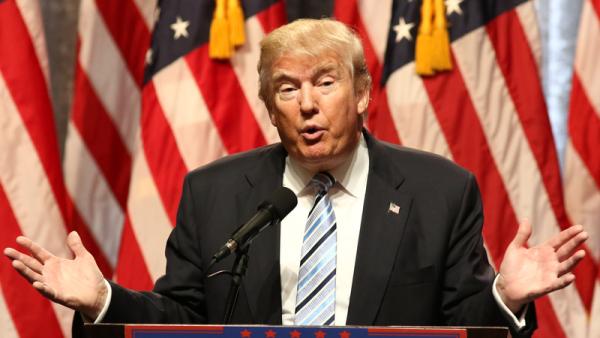US-China relations: A controversial framing
JStone / Shutterstock

Elena Collinson, Senior Project and Research Officer, Australia-China Relations Institute, University of Technology Sydney |
This article appeared in the Australian Institute of International Affairs’ blog, Australian Outlook, on May 9 2019.
On April 29, the US State Department’s Director of Policy Planning Kiron Skinner presented a controversial articulation of US-China relations. Speaking at a security forum in Washington DC, she framed US relations with China as, “A fight with a really different civilisation and a different ideology” and “the first time that we will have a great power competitor that is not Caucasian.”
That the United States views its conflict with China as grounded in ideological competition was enunciated by Vice President Mike Pence in a combative speech on October 4 last year, a perspective highlighted again last month by US Assistant Secretary of Defence for Indo-Pacific Security Affairs Randall Schriver. But Skinner’s comments extended that conceptual framework, grounding differences between the two countries firmly along broad West versus East lines, between “us” and “them” and going beyond the battle lines of the Pence speech.
Skinner’s remarks have been roundly criticised by a slew of observers and analysts in the United States, Australia and elsewhere. Australian government officials, speaking anonymously, quickly distanced their country from the mindset enunciated by Skinner. One Australian official unequivocally stated, “we do not share this view” and termed it “deeply unhelpful.” Indeed, the deputy chair of Australia’s Parliamentary Joint Committee on Intelligence and Security, Anthony Byrne, himself a staunch proponent of the Australia’s alliance relationship with the United States and supporter of the view that Australia “should look at our [relationship with China] through the prism of our relationship with the Americans,” condemned the comments as “deeply offensive, wrong and very counterproductive.”
Certainly, for Australia, Skinner’s analysis conjures up unhappy memories. It is reasonable to point to political scientist Samuel Huntington’s thesis on the clash of civilisations, first proposed in 1992, as the intellectual starting point for Skinner’s rather radical rhetoric. Indeed, Skinner conceded that her view incorporates “some [Huntingtonian] tenets.” In his 1996 book expanding on his thesis, Huntington had singled out Australia and charged Australian political leadership in the early 1990s with “trying to delink their country from the West and make it a part of Asia, thereby creating a torn-country-in-reverse.” He had forecast that Paul Keating’s Asian engagement strategy would ultimately constitute a “major marker in the decline of the West.”
Skinner’s use of the descriptor “non-Caucasian” as a notable point of difference between the United States and China was perhaps not a deliberate attempt to inject a measure of racial hostility into US-China relations. But some critics might be tempted to see a strong Trumpian influence in this given the instinct in the administration of President Donald Trump to retreat to race-based rhetoric in the interests of short-term political and economic expediency. For example, the president has: described African nations, as well as Haiti and El Salvador, as “shithole countries;” has on more than one occasion wheeled out the trope of Mexicans being “drug dealers,” “criminals” and “rapists” in order to justify immigration reform; and has accused a judge with Mexican heritage of not being able to provide a fair hearing. In these instances, there is exhibited a readiness to relegate diplomacy for race-flavoured rhetoric.
At the core of Skinner’s US-China relations framework is a clear and relatively established point: effectively, that China today poses a unique challenge for the United States and that the nature of US-China competition necessitates a different approach to China than that taken vis-à-vis the Soviet Union during the Cold War. There is support for this in the mainstream American political establishment and it is likely to underpin the approach of any post-Trump administration to the US-China relationship.
But building on that core to frame conflict with China along civilisational lines, potentially with racial underpinnings, is strategically ill-advised, to say the least, and fraught with medium- and long-term danger. Skinner’s comments merit scrutiny as they are potentially reflective of a serious strand of thought in the Trump administration. At the moment this is evinced by the fact that her comments have not as yet been disavowed, despite parts of the administration being provided public platforms to clarify. The US Under Secretary of State for Political Affairs David Hale, for example, when asked whether the State Department viewed the conflict with China “as a clash of civilisations in the Samuel Huntington sense,” did not confirm the proposition but neither did he rebut it. It might also point to a flourishing neo-conservative agenda in policymaking ranks. Skinner’s remarks elicited praise, for example, from Steve Bannon, Trump’s former chief strategist, who described her as a “patriot.”
The “fight with a really different civilisation” supposition provides Beijing with a domestic rallying cry. It conflates the US clash with Beijing’s Communist Party with a clash with the totality of the Chinese population. This simply boosts the Chinese Communist Party’s (CCP) intensive efforts toward cultivating a party-centric nationalism in the domestic sphere. That is, a belief that dedication to country necessarily means a dedication to the CCP, and that differences with the party mean differences with the country. It also alienates broad swathes of the Chinese diaspora.
While US allies and partners have not publicly commented on the matter, they are surely taking note of these developments. To non-Western nations, the idea that the United States views the potential for conflict as predicated on yawning chasms between civilisations, and that such chasms cannot be bridged, might be deeply disturbing. To Western nations with emphatically multicultural societies and/or significant ties to non-Western countries, being seen to actively support and align themselves with such a proposition is uncomfortable. Certainly, it would set alarm bells ringing in, for example, Canberra. Using civilisation to justify conflict diminishes confidence in supporting a US-led liberal international order.
To exacerbate this, Skinner in her security forum observations also seemed to indicate that there are some principles, such as advocating for human rights, that are inherently Western and, therefore, wielding them in a non-Western setting is ineffective. This undercuts the American championing of universal values, causing the United States to effectively “[sacrifice] the moral high ground,” as one observer recently put it. It allows for an attempt by Beijing to reposition itself in the international community and project itself as a pillar of the rules-based open trading system. Indeed, the Global Times, the nationalistic tabloid which provides a glimpse into CCP thinking, editorialised in its English-language edition that “over the last two years, the US has precisely and severely harmed Western civilisation and trampled on international rules universally acknowledged by the West. Chinese society has always respected Western civilisation, and learning from the West has always been one of the collective creeds of Chinese intellectuals.”
Finally, and perhaps most importantly, framing China as an existential threat in this vein eliminates the potential for compromise and halts the impetus for any kind of reconciliation. This is dangerous territory, with potential reverberations that would be felt globally.
Ultimately, adding a civilisational – and perhaps racial – premise to the attempt to revise US grand strategy toward China smacks, at best, of an unwise short-sightedness that risks having, for the US, the opposite effect to that intended.
Author
Elena Collinson is a senior researcher at the Australia-China Relations Institute, University of Technology Sydney.

